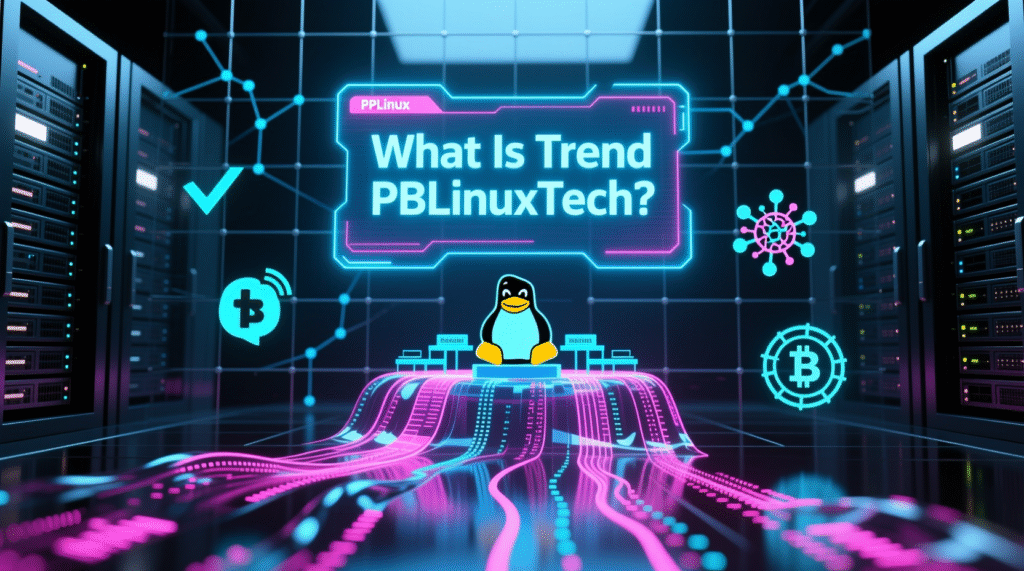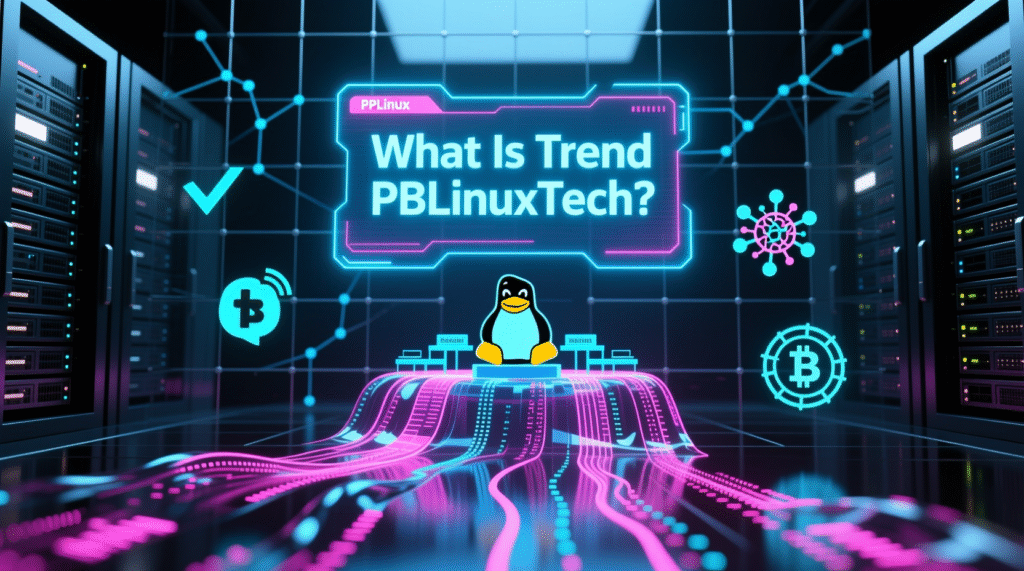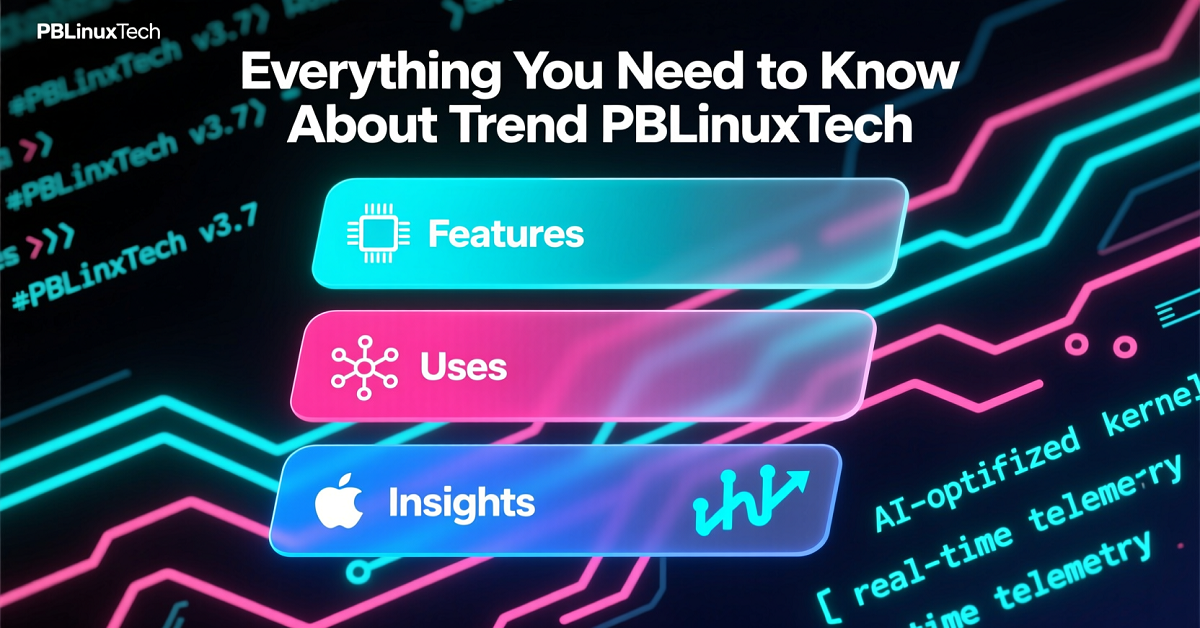PBLinuxTech is making waves in the open-source world, offering a lightweight, powerful, and community-driven Linux-tool ecosystem. In a world where performance, security, and modularity are more critical than ever, Trend PBLinuxTech has emerged as a noteworthy project for IT administrators, developers, students, and hobbyists tinkering with servers at home. This guide explores what Trend PBLinuxTech is, its key features, real-world uses, how to get started, its security practices, vibrant community, and what’s coming next. Let’s dive
What Is Trend PBLinuxTech?

Trend PBLinuxTech is an emerging open-source project (launched circa 2021) focused on developing smart tools for system optimization, performance monitoring, and automation—primarily for Linux distributions, especially Ubuntu and Debian-based systems.
Key elements:
| Attribute | Details |
|---|---|
| Founding | Community-driven; no single publicly disclosed founder. |
| Core Focus | Open-source software, system optimization, performance tools. |
| Platform Base | Linux (Ubuntu / Debian distributions predominantly). |
| Target Audience | Developers, students, IT administrators, tech enthusiasts. |
| Notable Projects/Modules | PB-Optimizer, PB-Monitor, PB-AutoSetup. |
Trend PBLinuxTech aims to provide utilities that are both beginner-friendly and useful for more advanced users—meaning you don’t need to configure every detail manually but you can if you want to.
Key Features That Set Trend PBLinuxTech Apart
Here are the standout features that make Trend PBLinuxTech more than “just another Linux tool suite.”
Open-Source Flexibility and Licensing
- Licensed under MIT or GPL (or similarly permissive/dual licenses) so anyone can view, contribute, or modify the code. This drives transparency and trust.
- Auditable scripts: since most scripts are small and modular, they’re easier to inspect for vulnerabilities or performance issues. Security through simplicity.
Lightweight System Optimization (PB-Optimizer)
- One-click tools that clean and tune systems. Tasks like removing unused packages, cleaning caches, optimizing kernel parameters, adjusting I/O scheduler, etc.
- Good for legacy hardware. If your machine has limited RAM or an older CPU, you’ll benefit. According to some user reports, performance improvements of 10-30% in responsiveness (boot time, UI lag, disk IO) have been achieved depending on baseline. (Note: specific benchmark numbers depend on system; community provides testimonials.)
Real-Time Performance Monitoring (PB-Monitor)
- Provides real-time metrics (CPU usage, memory, disk I/O, network) with minimal resource overhead.
- Portable scripts across distributions: tools work on Ubuntu, Debian, and many derivatives.
- Often used in server/droplet/cloud instances to keep an eye on resource usage for optimization or to catch issues before they escalate.
Automation & Cloud-Ready Tools
- PB-AutoSetup: automates setup of basic server environments (install typical packages, security hardening, user setup).
- Integration / friendly use with Cron jobs, Jenkins, and cloud services like AWS, DigitalOcean, Linode for scheduled tasks, backups, resource monitoring.
- Future roadmap includes Dockerized versions of tools to make deployments more portable. (More on that later.)
Modular Architecture & Customizability
- Modular approach: you install only what you need (Optimizer, Monitor, AutoSetup etc.), avoiding bloatware.
- Tools are largely built with shell scripting (bash) and Python, making them accessible to those comfortable with scripting. You can tweak them.
- Custom modules or plugins can be introduced by community contributions.
Practical Uses and Real-World Applications
To understand value, here are real-life scenarios where Trend PBLinuxTech is making a difference.
| Use Case | Description & Example |
|---|---|
| Educational Institutes | Universities or technical colleges use PB-Monitor in labs so students can visually see system metrics (CPU, RAM, disk). Teachers report that this improves comprehension of resource constraints. |
| Startups & Small Businesses | Using PB-AutoSetup + PB-Monitor to quickly spin up virtual servers for web apps, while keeping infrastructure costs low. For example, a small SaaS startup may deploy on a DigitalOcean droplet, monitor resources, and auto-scale or tweak based on data from PB-Monitor. |
| Home Labs / Hobbyists | Enthusiasts using older hardware or Raspberry Pis install PB-Optimizer to squeeze performance. Also, automating backups via Cron + AutoSetup. |
| Coding Bootcamps & Hackathons | Where teams need quick environment setup, minimal UI overhead, and tools that “just work”. The lightweight nature speeds up onboarding. |
Example anecdote: A bootcamp instructor in Delhi reportedly used PB-Monitor to allow students to monitor their VM’s CPU / memory in real time. This helped students understand how memory leaks or unoptimized code impacted performance. (Source: community threads / feedback)
Community and Ecosystem Strength
Trend PBLinuxTech is more than the code—it’s the people.
- GitHub is the central hub: hundreds of contributors submit patches, feature requests, bug fixes. Active pull requests help keep up with new Linux versions.
- Discord, Reddit, Wiki/documentation: these platforms provide tutorials, help, discussions, weekly AMAs (Ask Me Anything). Beginners and experts mingle.
- Documentation is volunteer-led but frequently updated. Users often share their custom configs, tips, patches. This speeds adoption and trust.
Security and Maintenance Practices
Security is built into Trend PBLinuxTech’s DNA.
- Minimal and auditable scripts: the smaller the script, the easier to audit. Complexity is reduced.
- Frequent updates: when vulnerabilities or bugs are reported, they are fixed via community patches and pull requests.
- Trusted contributors: reviewers verify changes; code reviews are part of the process.
- Strong encouragement to sandbox or test in virtual machines before deploying to production environments.
- Recommended best practices: use latest stable kernel, updated packages, secure remote access (SSH keys), firewall rules (iptables/nftables), etc.
How to Install Trend PBLinuxTech’s Tools
Here’s a hands-on guide to get started, with tips to avoid common pitfalls.
- Clone the GitHub Repository
git clone https://github.com/trendpblinuxtech/tools.git cd tools - Run the Setup Script
sudo ./install.sh- The installer will prompt you to choose modules (PB-Monitor, PB-Optimizer, PB-AutoSetup).
- Ensure you’re running this with sufficient permissions.
- Choose Modules and Configure
- If you have limited resources (old laptop, low RAM), choose only PB-Optimizer and PB-Monitor.
- For servers, include PB-AutoSetup to automate environment provisioning and security hardening.
- Post-Install Configuration Tips
- If using on cloud servers (AWS, DigitalOcean, Linode), set up proper monitoring and alerts. PB-Monitor can be paired with existing dashboards.
- Regularly update:
git pulland reapply install or update modules as community releases come. - Backup configuration files before modifications.
Expertise Tips: Getting the Most Out of Trend PBLinuxTech
Here are some pro tips, based on community feedback and usage:
- Follow GitHub commits: watching the commit history helps you catch breaking changes or optimizations early.
- Combine with existing tools: e.g., use PB-Monitor + your current cloud provider’s monitoring or Grafana, especially if you’re running dashboards.
- Use auto-optimization during off-peak: schedule PB-Optimizer to run during low usage times (via cron or Jenkins) so performance enhancements don’t interfere with active workload.
- Test in virtualized environment first: especially if integrating with production servers.
- Contribute back: writing documentation, submitting bug reports or small features increases maturity of tools and community trust.
Comparison with Similar Open-Source Projects
To help you see where Trend PBLinuxTech stands, here’s how it compares with other tools or ecosystems.
| Competitor / Tool | Strengths | Where Trend PBLinuxTech Has the Edge |
|---|---|---|
| Nagios / Zabbix | Very powerful monitoring, many plugins, enterprise scale | Trend PBLinuxTech is lighter, easier to set up, less overhead, better for small / home / cloud droplet scenarios |
| Ansible / Puppet / Chef | Infrastructure as Code, config management, complex orchestrations | PBLinuxTech is simpler, more focused on system tuning + monitoring + optimization rather than full infra orchestration |
| Cockpit | Web GUI, server management via browser | Trend PBLinuxTech aims to offer lightweight tools, CLI + optional GUI; less resource-heavy; better for minimalist / legacy setups |
| Other Optimization Suites or Scripts | Specific tasks, maybe proprietary, or less maintained | PBLinuxTech has active community, auditability, and modular toolkit; free and open-source licensing ensures long-term maintainability |
Future Roadmap and Innovations
What’s coming up? Based on public discussions and roadmap notes:
- Web GUI: Remote monitoring via browser – makes PB-Monitor more accessible, especially for users not comfortable with CLI.
- Dockerized versions of all modules, which will allow running each tool in a container for isolation and portability.
- AI-based optimization suggestions: Using telemetry (where allowed) + logs to suggest optimizations automatically (e.g., which module to enable, which parameter to adjust).
- Multilingual support: Documentation, prompts, GUIs in more languages to make tools truly global.
- Better cross-platform compatibility: Some Python-based modules may already run on macOS with tweaks; windows support minimal (through Python), but this is less of a focus.
Which Users Benefit Most from Trend PBLinuxTech?

Here’s a guide to who gets the most out of it:
| User Type | What They Gain |
|---|---|
| Beginners / Students | Easy startup tools; learning Linux; seeing realtime feedback; growing awareness of system fundamentals. |
| IT Administrators / DevOps | Quick monitoring + optimization; less resource usage; automation that integrates with existing tools; proactive detection of issues. |
| Hobbyists / Home Labs | Running older hardware; building home servers / NAS; automation of backups; lightweight monitoring. |
| Startups / Small Businesses | Cost-efficient cloud resource monitoring; speeding up server provisioning; low maintenance overhead. |
FAQs About PBLinuxTech
Q1: Is Trend PBLinuxTech suitable for non-technical users?
Yes. Some tools (like PB-Optimizer) are designed to use prompts that guide you, and documentation / wiki is beginner-friendly. However, basic comfort with the command line (SSH, installing packages) helps.
Q2: Can I contribute to the project?
Absolutely. Being open-source, contributions via GitHub pull requests (code or documentation) are encouraged. Issues & feature suggestions are welcomed too.
Q3: Does it work on Windows or macOS?
Primarily built for Linux. Some Python modules may run on macOS with adjustments. Windows support is minimal / via workaround (such as using WSL). It’s not designed for Windows desktops as a primary platform.
Q4: Is there any cost involved?
No. All tools are free under open-source licenses (MIT, GPL etc.). No subscription fees.
Q5: Where can I find further learning resources?
- GitHub repository & Wiki
- Discord and Reddit community forums
- Community tutorials, blog posts
- Using examples / templates shared by others
Conclusion
Trend PBLinuxTech is more than just an assortment of Linux utilities it’s a growing movement emphasizing lightweight performance, community involvement, security by design, and meaningful automation. Whether you’re working in a cloud environment, managing servers, in an educational setting, or simply reviving older hardware, there’s something here for you.
If you’re curious, clone the repo, try PB-Optimizer, experiment with PB-Monitor, and get involved in the community. The open-source mindset isn’t just about code—it’s about people helping each other build better tools.
If you like, I can prepare a version of this article tailored for an audience in Pakistan (including locally relevant cloud providers, hardware constraints, etc.). Do you want that?









